
The Battle of Cecora took place during the Polish–Ottoman War (1620–21) between the Polish–Lithuanian Commonwealth and Ottoman forces, fought from 17 September to 7 October 1620 in Moldavia, near the Prut River.
The Moldavian Magnate Wars, or Moldavian Ventures, refer to the period at the end of the 16th century and the beginning of the 17th century when the magnates of the Polish–Lithuanian Commonwealth intervened in the affairs of Moldavia, clashing with the Habsburgs and the Ottoman Empire for domination and influence over the principality.

Samuel Korecki nobleman (szlachcic) of the Polish–Lithuanian Commonwealth, adventurer and military commander carrying a titular rank of colonel. His coat of arms was Pogonia. He spent his life as a military men, fighting both private and state sponsored wars.
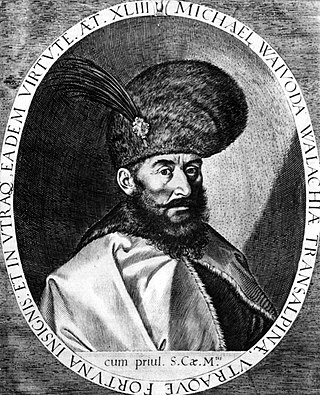
Michael the Brave, born as Mihai Pătrașcu, was the Prince of Wallachia, Prince of Moldavia (1600) and de facto ruler of Transylvania (1599–1600). He is considered one of Romania's greatest national heroes. Since the 19th century, Michael the Brave has been regarded by Romanian nationalists as a symbol of Romanian unity, as his reign marked the first time all principalities inhabited by Romanians were under the same ruler.
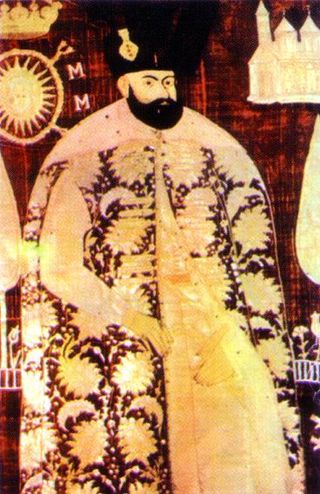
Ieremia Movilă was a Voivode (Prince) of Moldavia between August 1595 and May 1600, and again between September 1600 and July 10, 1606. At the time, Moldavia was a vassal province of the Polish-Lituania CommonWealth.
The early modern times in Romania started after the death of Michael the Brave, who ruled in a personal union, Wallachia, Transylvania, and Moldavia – three principalities in the lands that now form Romania – for three months, in 1600. The three principalities were subjected to the Ottoman Empire, and paid a yearly tribute to the Ottoman Sultans, but they preserved their internal autonomy. In contrast, Dobruja and the Banat were fully incorporated into the Ottoman Empire.
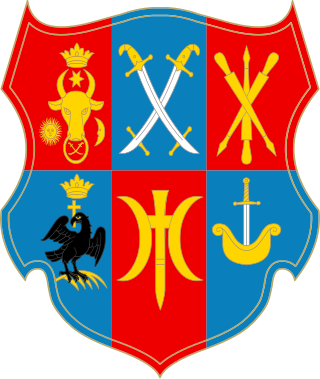
The House of Movileşti, also Movilă or Moghilă, was a family of boyars in the principality of Moldavia, which became related through marriage with the Mușatin family – the traditional House of Moldavian sovereigns.
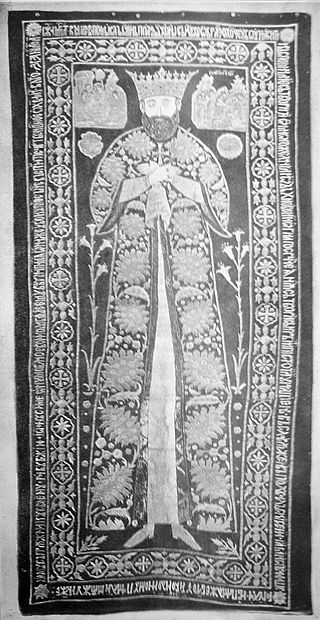
Simion Movilă, a boyar of the Movilești family, was twice Prince of Wallachia and Prince of Moldavia from July 1606 until his death.

The Khotyn Fortress is a fortification complex located on the right bank of the Dniester River in Khotyn, Chernivtsi Oblast (province) of southwestern Ukraine. It lies within the historical region of northern Bukovina, a Romanian territory occupied in 1940 by the Soviet Union following the Molotov–Ribbentrop Pact. The fortress is located near another famous defensive structure, the Kamianets-Podilskyi Castle. Construction of the current stone Khotyn Fortress began in 1375. The fortress underwent significant improvements in the 1380s and in the 1460s under the Moldavian princes Alexander the Good and Stephen the Great.

The Battle of Cecora took place on October 19–20, 1595, during an expedition of Jan Zamoyski, of the Polish–Lithuanian Commonwealth, to Moldavia, as part of the Moldavian Magnate Wars.
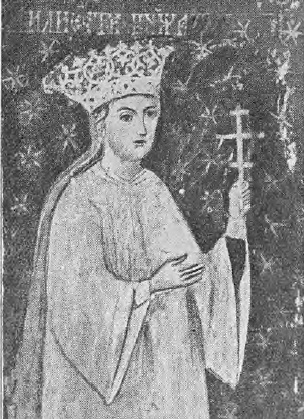
Doamna Elisabeta Movilă was a Princess consort of Moldavia by marriage to Ieremia Movilă. She was regent in Moldavia in 1607–1611 on the behalf of her son Constantin I Movilă and her son Alexandru Movilă in 1615–1616. She was described as proud, ambitious and beautiful.
The Battle of Cornul lui Sas took place on 9 July 1612 between the forces of Ștefan IX Tomșa, the ruler of Moldavia, and the Budjak Horde led by Khan Temir ), and a private army assembled by Stefan Potocki, voivode of Bratslav in the (Polish–Lithuanian Commonwealth in order to reinstall his brother in law Constantin Movilă as Moldavian ruler. By tacking this stance, Potocki openly defied the king's order to avoid any conflict with Ottomans. The battle resulted in a clear defeat of the Potocki's army. Both Stefan Potocki and Constantin Movilă's mother, Elisabeta Movilă were captured by Ottomans.
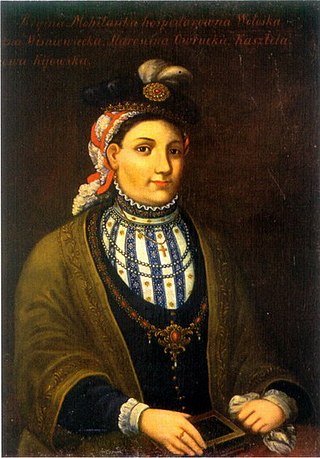
Regina Wisniowiecka was a Polish noble lady originally from Moldavia. She was a wife of Michał Wiśniowiecki and patron of Eastern Orthodox Christianity in the Polish–Lithuanian Commonwealth.

Costea Bucioc or Coste Băcioc was a Moldavian statesman, commander of the military forces, and father-in-law of Prince Lupu (Vasile) Coci. He began his political career in the 1580s, emerging in the late 1590s as an ally of the Movilești dynasty, with then-Prince Ieremia Movilă advancing him to the post of Clucer. From 1601, he was Constantin Movilă's Paharnic, receiving from him the estate of Deleni and other villages around Hârlău, which formed part of a Bucioc domain that also extended into Bukovina and Bessarabia. Together with the Movilești, he became one of the great landowners of his generation, and one of the first Moldavian boyars known to have owned serfs. Some of his assets went into refurbishing Râșca Monastery, of which he was patron, or ktitor.
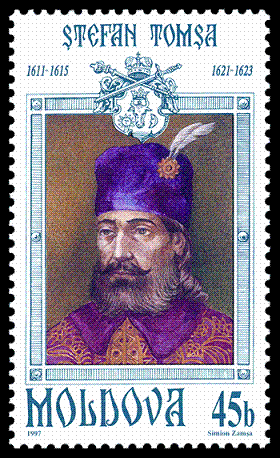
Stefan Tomşa IX, of Moldavia was Prince of Moldavia for two reigns, in 1611–1615 and in 1621–1623. His reigns were concurrent with the period of Romanian and Eastern European history known as the Moldavian Magnate Wars, a long conflict in the early modern states of Moldavia, Wallachia, and Transylvania, in which the Moldavian state was alternatively influenced by the Austrian Habsburgs, the Ottoman Empire, and the Polish–Lithuanian Commonwealth. He was placed on the throne of Moldavia in 1611 following the deposition of the preceding Prince, Constantin Movila by the Ottomans, in the same year as Radu Mihnea was placed on the throne of neighboring Wallachia.
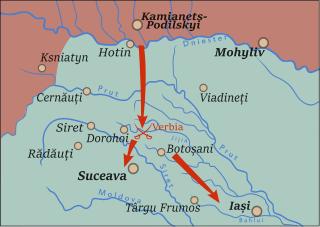
The Battle of Verbia was the decisive episode in Iacob Heraclid (Despot)'s invasion of Moldavia, taking place on November 18, 1561. Heraclid and Olbracht Łaski's army was backed by the Holy Roman Empire and possibly also by the Knights Hospitaller; it comprised foreign mercenaries, including Spaniards armed with arquebuses, making this the first battle in Moldavian history to be won by superior firepower. The Moldavian military forces under Prince Alexandru Lăpușneanu were backed by Janissaries, but lost crucial support from the cavalry when commander Moțoc defected to the enemy. From the village of Verbia, located outside Dimăcheni, Heraclid's Hungarian troops stormed into Botoșani, slaughtering the surviving Janissaries.
Constantin Movilă was the Prince of Moldavia from 1607 to 1611. The son of Prince Ieremia Movilă and driven by his mother, the ambitious Erszébet Csomortany de Losoncz, he twice seized the Moldovan throne at the expense of his cousin Mihai Movilă, son of Simion I Movilă in 1607.
Alexandru Movilă was Prince of Moldavia from 1615 to 1616.

Jan Zamoyski's expedition to Moldavia was a successful military campaign in 1595 that aimed to establish Moldavia as a Polish vassal state.
Moldavian–Polish War may refer:
















